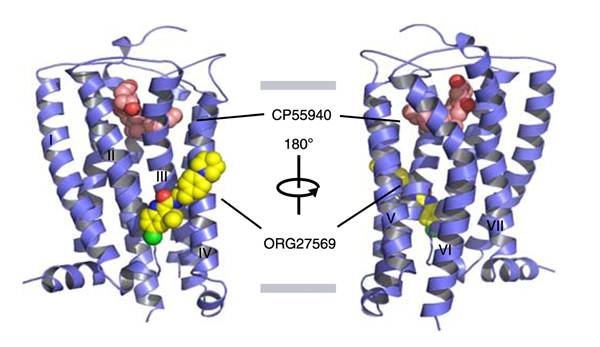The team of Zhenhua Shao, a research fellow of State Key Laboratory of Biotherapy, West China Hospital, has published in Nature Chemical Biology ( IF=12.15 ) a research paper “Structure of an allosteric modulator bound to the CB1 cannabinoid receptor”. This study was completed as a cooperation project between Zhenhua Shao research team and Professor Danile Rosenbaum, the University of Texas Southwestern Medical Center. The first work unit of this paper is the State Key Laboratory of Biotherapy and the Nephrology and Kidney Research Institute of West China Hospital. Zhenhua Shao is the first author, and Wei Yan, an associate research fellow, is the second author. The doctoral student of Xuehui Wang has taken part in the research.
Cannabinoid receptor CB1 belongs to GPCR ( G protein coupled receptor ) Class A family, which is highly expressed in human nervous system. Cannabinoid drugs regulate physiological response in vivo by activating such receptors. CB1 receptor has always been a target for the treatment of pain, anxiety and seizures. Its agonist and antagonist ligands recognize the positive site of CB1 receptor and regulate the opening and closing of signal pathway respectively. In addition to positive coordination ( agonists and antagonists ), allosteric modulators not only affect the binding of cannabinoid agonists, but also have the ability to regulate signal transduction. Understanding the molecular mechanism of allosteric regulators will help us better understand the complex mechanism of GPCR signal transduction.

Structural diagram of ternary complex of cannabinoid receptor CB1 with agonist ligand cp55940 and allosteric regulator org27569
By analyzing the three-dimensional structure of CB1 receptor and negative allosteric modulator, we have found a new recognition site of negative allosteric modulator in CB1 receptor, which is different from GPCR allosteric regulator previously found. On the one hand, this paper will help us understand the signal transduction mechanism of CB1 receptor more systematically. More importantly, the synergistic effect of allosteric regulators and agonists (possibly with low side effects) provides a new way for drug development of CB1 receptor.
Article link: https://www.nature.com/articles/s41589-019-0387-2
